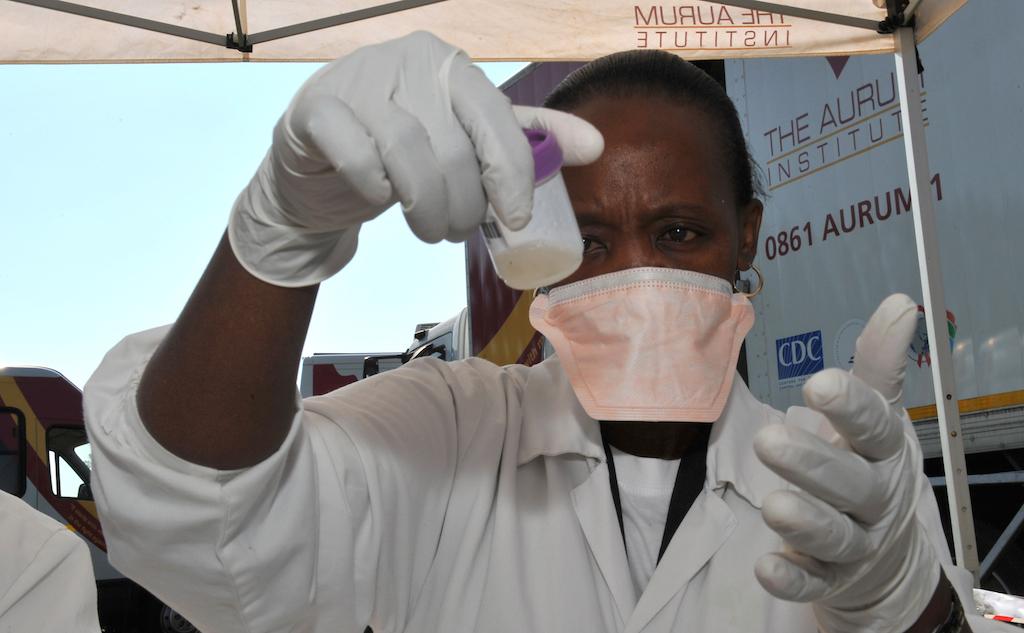Southern African countries commit to address mineworkers’ TB
A medical worker is pictured at a mobile testing facilities for tuberculosis (TB) at Driefontein Gold Mine in Carletonville, South Africa on March 24, 2012. Deputy President Kgalema Motlanthe launched a national TB control plan amongst gold miners, beginning with a programme to test workers.
In 1902, Lord Alfred Milner, Britain's administrator in South Africa, appointed a commission to find out why so many workers in the territory’s lucrative gold and diamond mines were developing tuberculosis. Breathing in silica dust — abundant in mines and quarries — was the main culprit, the commission found. It said there was “urgent need” for reform to protect workers.
More than a century later, the fatal infectious disease has not eased its grip in the region. Miners in South Africa and neighboring countries have the highest TB infection rates in the world. In South Africa, the incidence of the disease was more than 1,000 out of every 100,000 people in 2012, and the country’s 2.5 million current and former mineworkers are most at risk.
But new efforts are underway to tackle the epidemic at a regional level and involve more mining companies in addressing the crisis.
To mark World TB Day, ministers from southern Africa met in Johannesburg on Tuesday to develop a regional strategy for reducing TB among mineworkers. Leaders from South Africa, Lesotho, Mozambique and Swaziland — the four countries home to the largest share of new infections in the region — agreed to a framework that will help track patients across borders and set common treatment standards. Other regional heads committed to exploring options for collaboration.
“In the whole region we share labor, we share communities, and we share labor-sending areas. But we haven’t had a clear program for how to work together,” South African health minister Aaron Motsoaledi said in a press release.
Those who convened the meeting say the approach will only work if it also involves the mining industry. The World Bank and the Global Fund to Fight AIDS, Tuberculosis and Malaria, which sponsored the meeting with Stop TB Partnership, have pledged $100 million each to fighting TB in the region if mining companies sign onto a public-private partnership with matching resources.
"This is not just a health matter but it is also an economic, social and development issue especially for southern Africa,” South Africa’s Deputy President Kgalema Motlanthe said at the meeting. “This disease, which is the leading cause of death in our country, has a huge impact on workforce productivity and operational costs in an industry that contributes almost 20 percent to South Africa's GDP.”
At the meeting, the World Bank presented the preliminary results of a study that showed there was a 40:1 benefit-cost ratio to treating TB in southern Africa. For R330 million (about $31 million), the four countries represented at the meeting could rack up R13 billion (more than $1.2 billion) in economic benefits, not to mention save 3,000 lives, within 15 years, the study showed.
South Africa is taking the lead, launching an ambitious TB testing initiative, Motsoaledi announced Tuesday. The government plans to verbally screen half a million mineworkers, 600,000 residents of nearby communities and 150,000 prison inmates with R500 million (roughly $46.5 million) from the Global Fund.
The move toward a cross-border approach to TB began two years ago, when heads of state from the Southern African Development Community signed a declaration to address the prevalence of TB and HIV among mineworkers. Since then, health ministries in South Africa, Lesotho, Mozambique and Swaziland have begun aligning their regulations on TB.
Some mining companies already offer treatment programs for their employees. But workers regularly migrate across mines and national borders, or temporarily leave work sites for home. When that happens, treatment is interrupted or stops altogether. This increases drug resistance, a growing problem in the region.
“When miners are not able to access drugs either at home or in smaller mines that do not provide diagnosis and treatment, TB, and drug-resistant TB, spreads in their families and communities,” Motsoaledi and Mark Dybul, executive director of the Global Fund, wrote in an editorial this week.
Some companies have said they’re willing to expand programs to follow miners as they relocate, mirroring existing HIV programs, Motsoaledi and Dybul wrote.
Around half a million people work in South African mines, and nearly two million former workers live in the region, according to the World Bank.
Miners are at much higher risk for developing TB than the general population. This is not only because of silica dust, but also due to crowded housing conditions and the prevalence of HIV.
The TB crisis could spread as mining intensifies across Africa. Minerals are already the continent’s second-largest export after oil and gas, and resources remain unexploited in most countries.
More from GlobalPost: Why Africa's drug-resistant tuberculosis is proving so hard to fight
The story you just read is accessible and free to all because thousands of listeners and readers contribute to our nonprofit newsroom. We go deep to bring you the human-centered international reporting that you know you can trust. To do this work and to do it well, we rely on the support of our listeners. If you appreciated our coverage this year, if there was a story that made you pause or a song that moved you, would you consider making a gift to sustain our work through 2024 and beyond?
